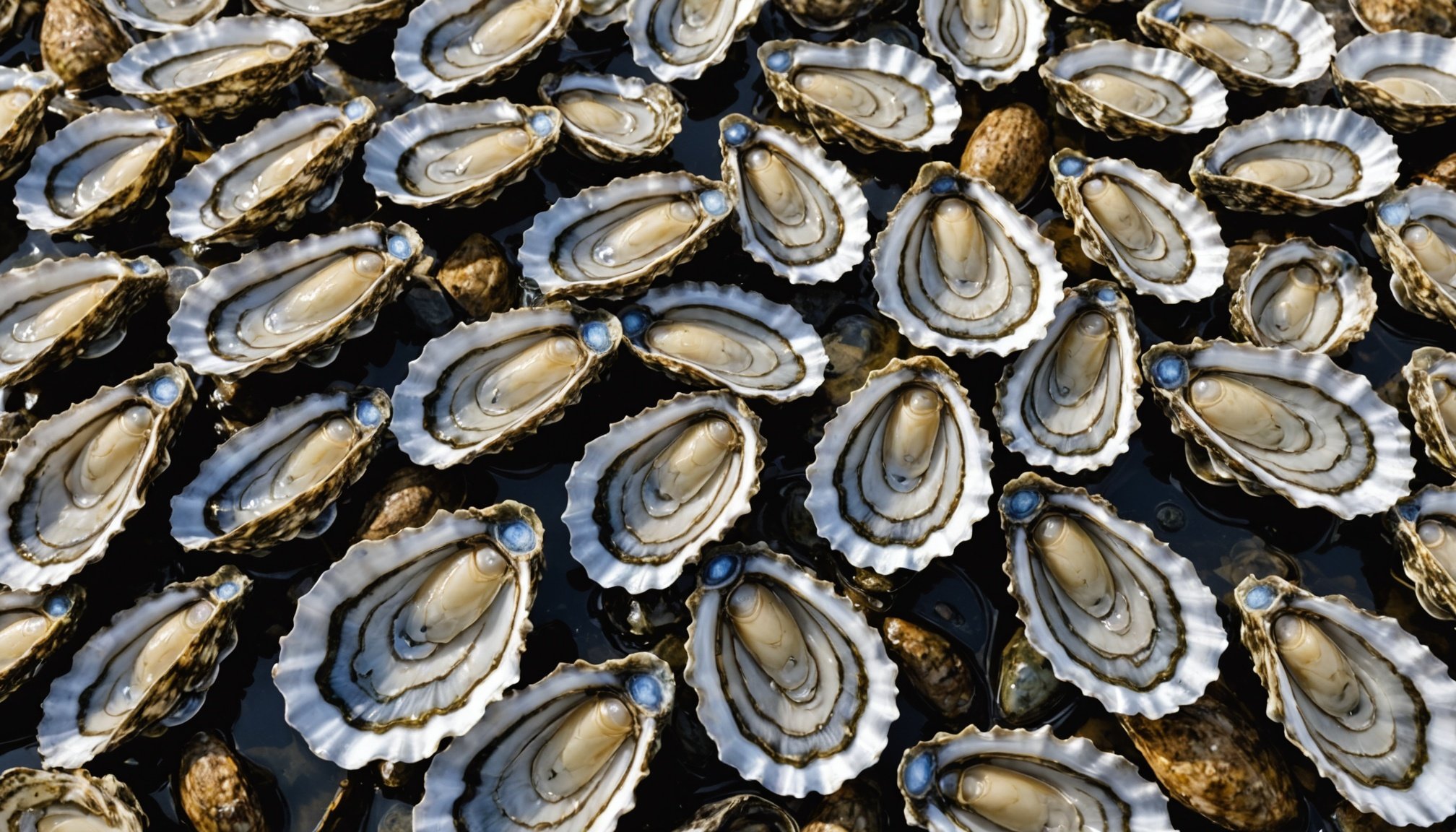Reviving Oyster Populations: Strategies for UK Coastal Regions to Foster Recovery
The revival of oyster populations in the UK’s coastal regions is a complex and multifaceted endeavor that involves scientific research, conservation efforts, and community engagement. Here, we delve into the strategies and initiatives that are being implemented to restore these vital marine ecosystems.
Understanding the Importance of Oysters
Oysters, particularly the European flat oyster (Ostrea edulis), play a crucial role in marine ecosystems. They are biogenic reef builders, providing habitat for numerous species, improving water quality, and protecting coastlines from erosion. However, centuries of overfishing, habitat degradation, and disease have led to the significant decline of wild oyster populations.
Topic to read : Revolutionizing UK Coastal Development: Cutting-Edge Approaches to Safeguard Marine Turtle Nesting Sites
Ecosystem Services Provided by Oysters
- Habitat Creation: Oyster reefs serve as nurseries for many marine species, including fish, crustaceans, and other invertebrates.
- Water Quality Improvement: Oysters filter large volumes of water, removing pollutants and sediments, which enhances water clarity and quality.
- Coastal Protection: Oyster reefs act as natural barriers against storms and erosion, protecting coastal areas and infrastructure.
- Biodiversity Enhancement: Oyster reefs support a diverse array of marine life, contributing to overall ecosystem health and biodiversity.
Historical Context and Current Status
Historical records indicate that European flat oysters were once widely distributed across European coastal seas. However, from the 19th century onwards, industrial fishing and habitat degradation led to the collapse of these populations. Today, there are almost no extant examples of healthy and natural biogenic reef ecosystems for this species.
Challenges in Restoration
- Lack of Historical Data: The long period of exploitation has resulted in a scarcity of data on the natural distribution and extent of oyster reefs, making it challenging to set evidence-based restoration goals.
- Funding and Resources: Securing funding and resources is a significant challenge for large-scale restoration projects. Collaborating with experts and identifying reliable habitat banks are crucial steps in overcoming these obstacles.
Restoration Strategies
Several innovative strategies are being employed to restore oyster populations in the UK.
Also to read : Enhancing City Ecosystems: The Crucial Impact of UK Community Gardens on Nature Conservation
Habitat Restoration Projects
Projects like the one in the Bay of Firth, led by North Bay Innovations Ltd, aim to re-establish native oysters in their natural habitats. These initiatives involve the reintroduction of oyster spat and the creation of suitable substrates for oyster growth.
Example: Bay of Firth Project
The Bay of Firth project is a prime example of community-driven restoration. With a grant from the Scottish government, this project focuses on restoring the native oyster population, which had been decimated by historical overfishing and habitat destruction.
Utilizing Offshore Wind Farms
Offshore wind farms are being leveraged as potential sites for oyster restoration. Companies like Ørsted and Van Oord are installing scalable oyster structures in the North Sea, taking advantage of the hard substrate and undisturbed seabed provided by these wind farms.
Benefits of Offshore Wind Farms
- Stable Substrate: Offshore wind farms offer a stable and hard substrate that is ideal for oyster growth.
- Undisturbed Seabed: The areas around wind farms are often protected from fishing and other human activities, providing an undisturbed environment for oysters to thrive.
Collaboration and Community Engagement
Collaboration between organizations, communities, and governments is essential for the success of oyster restoration projects.
Example: The Oyster Restoration Company and Mossy Earth
The Oyster Restoration Company’s collaboration with Mossy Earth for the Cromarty Seascape Project is a notable example. This partnership involves the donation of native oyster spat to boost the local oyster population, highlighting the importance of community and organizational collaboration in restoration efforts.
Practical Methods for Restoration
Several practical methods are being used to restore oyster populations.
Removal of Invasive Species
Removing invasive species is crucial for allowing native oysters to thrive. Invasive species can outcompete natives for resources, leading to reduced biodiversity.
Steps for Invasive Species Management
- Identification: Identify invasive species present in the area.
- Removal: Actively remove invasive species.
- Reintroduction: Reintroduce native species after removal.
Riparian Buffer Restoration
While primarily focused on freshwater habitats, the principles of riparian buffer restoration can be applied to coastal areas. Restoring these buffers by planting native vegetation helps protect water quality and create natural habitats for wildlife.
Benefits of Riparian Buffer Restoration
- Water Quality Protection: Native vegetation helps filter pollutants from the water.
- Habitat Creation: Provides a natural habitat for wildlife.
- Erosion Reduction: Helps reduce erosion along coastlines.
Marine and Coastal Habitat Restoration
Restoring coral reefs, mangroves, seagrass beds, and oyster reefs is critical for marine biodiversity. This involves reducing pollution, controlling fishing practices, and transplanting key species.
Example: Strangford Lough
Strangford Lough in Northern Ireland is a significant site for oyster restoration. Efforts here focus on reducing pollution, managing fishing practices, and reintroducing native oyster species to restore the health of the lough’s ecosystem.
Challenges and Future Directions
Despite the progress made, several challenges remain in the restoration of oyster populations.
Funding and Regulatory Compliance
Securing funding and navigating regulatory compliance are ongoing challenges. Understanding biodiversity net gain regulations and securing reliable funding sources are essential for the success of these projects.
Quote from Kennedy Roberts, Wildlife Trust
“Securing funding is a significant hurdle, but it’s crucial for the scale and impact of our restoration efforts. Collaborating with experts and ensuring compliance with regulatory requirements helps us navigate these complexities effectively.”
Community Engagement and Education
Community engagement and education are vital for the long-term success of oyster restoration projects.
Example: Conwy Bay
In Conwy Bay, local communities are being engaged through educational programs and volunteer opportunities. This not only raises awareness about the importance of oyster restoration but also fosters a sense of ownership and responsibility among community members.
Reviving oyster populations in the UK’s coastal regions is a multifaceted effort that requires scientific research, community engagement, and strategic planning. By understanding the historical context, leveraging innovative strategies, and addressing the challenges faced, we can work towards restoring these critical marine ecosystems.
Table: Comparison of Restoration Strategies
| Restoration Strategy | Benefits | Challenges | Examples |
|---|---|---|---|
| Habitat Restoration Projects | Reintroduction of native oysters, creation of suitable substrates | Funding, resource management | Bay of Firth Project |
| Utilizing Offshore Wind Farms | Stable substrate, undisturbed seabed | Limited availability of wind farms | Ørsted and Van Oord in the North Sea |
| Collaboration and Community Engagement | Community ownership, resource sharing | Coordination, funding | The Oyster Restoration Company and Mossy Earth |
| Removal of Invasive Species | Allows native species to thrive | Identification, removal costs | Various UK coastal regions |
| Riparian Buffer Restoration | Water quality protection, habitat creation | Limited applicability to coastal areas | Adapted from freshwater restoration techniques |
| Marine and Coastal Habitat Restoration | Reduces pollution, controls fishing practices | Funding, regulatory compliance | Strangford Lough |
Detailed Bullet Point List: Steps for Oyster Restoration
- Identify Historical Habitats: Use historical records to identify past oyster reef habitats and fisheries.
- Example: The Historical Ecology Working Group under the Native Oyster Restoration Alliance (NORA) has compiled a dataset of historical oyster fisheries and reef ecosystems across Europe.
- Assess Current Conditions: Evaluate the current state of the habitat, including water quality, substrate availability, and presence of invasive species.
- Example: Conducting surveys and monitoring programs to assess the health of the ecosystem.
- Remove Invasive Species: Actively remove invasive species that compete with native oysters.
- Example: Manual removal or biological control methods.
- Reintroduce Native Oysters: Reintroduce native oyster spat into the restored habitat.
- Example: The Oyster Restoration Company’s donation of native oyster spat for the Cromarty Seascape Project.
- Monitor and Maintain: Continuously monitor the health of the restored habitat and maintain the ecosystem through ongoing management practices.
- Example: Regular monitoring of water quality, oyster growth, and biodiversity.
By adopting these strategies and addressing the challenges faced, the UK can make significant strides in reviving its oyster populations, thereby enhancing marine biodiversity and ecosystem health.










